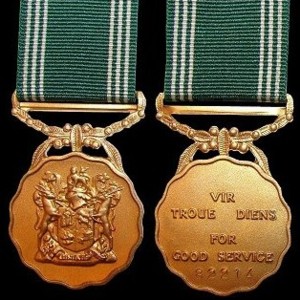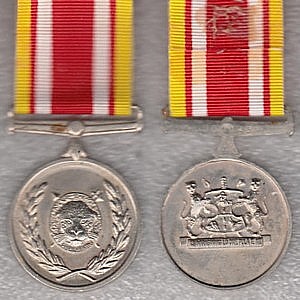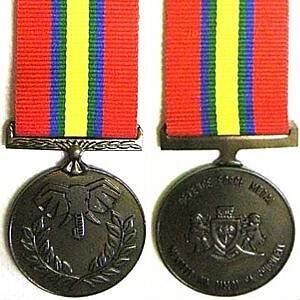
The Medalje vir Troue Diens - Medal for Loyal Service was instituted by the President of the Republic of South Africa on 16 April 2003 and came into effect on 27 April 2003. It can be awarded to all ranks whose character and conduct have been irreproachable and who have completed ten years of qualifying service.
An overview of South African military decorations and medals, which form part of the South African honours system.

The Permanent Force Good Service Medal was instituted by the Republic of South Africa in 1961, when South Africa became a republic, to replace the Union Medal. It was awarded to Permanent Force members of the South African Defence Force for eighteen years of service and good conduct.

The John Chard Decoration, post-nominal letters JCD, was a military long service decoration which was instituted by the Union of South Africa on 6 April 1952. It was awarded to members of the Citizen Force of the South African Defence Force for twenty years of efficient service and good conduct. Clasps could be awarded after thirty and forty years service respectively.

The John Chard Medal is a military long service medal which was instituted by the Union of South Africa on 6 April 1952. Until 1986, it was awarded to members of the Citizen Force of the South African Defence Force for twelve years of efficient service and good conduct. The period of qualifying service was reduced to ten years in 1986.

The De Wet Medal is a military long service medal which was instituted by the Republic of South Africa in 1987. It was awarded to members of the Commandos, the rural defence component of the South African Defence Force, for ten years of efficient service and good conduct.

The Good Service Medal, Bronze, originally named the South African Defence Force Good Service Medal, Bronze, is the junior of a set of three South African military medals which was instituted by the Republic on 1 July 1975. It was awarded to members of all elements of the South African Defence Force for ten years of exemplary service, but was restricted to Permanent Force personnel from 1993.

The Good Service Medal, Silver, originally named the South African Defence Force Good Service Medal, Silver, is the middle member of a set of three military medals which was instituted by the Republic of South Africa on 1 July 1975. It was initially awarded to members of all elements of the South African Defence Force for twenty years of exemplary service, but was restricted to Permanent Force personnel from 1993.

The Good Service Medal, Gold, originally named the South African Defence Force Good Service Medal, Gold, is the senior of a set of three military medals which was instituted by the Republic of South Africa on 1 July 1975. It was initially awarded to members of all elements of the South African Defence Force for thirty years of exemplary service, but was restricted to Permanent Force personnel from 1993.

The Union Medal was instituted by the Union of South Africa in 1952. It was awarded to Permanent Force members of the South African Defence Force for eighteen years of service and good conduct.

The Unitas Medal was instituted by the President of the Republic of South Africa on 4 November 1994. It was awarded to all ranks who were on the active strength of all seven constituent military forces from 27 April 1994 to 10 May 1994, to commemorate their amalgamation into the South African National Defence Force. It was also awarded to personnel of the British Military Advisory and Training Team which served in South Africa at the time.

The General Service Medal was instituted by the State President of the Republic of Bophuthatswana in 1991, for award to all ranks for operational service inside Bophuthatswana.

The Marumo Medal, Class I was instituted by the State President of the Republic of Bophuthatswana in 1988.

The Distinguished Service Medal, Gold was instituted by the President of the Republic of Venda in 1985, for award to all ranks for exceptionally meritorious service and particular devotion to duty.

The Venda Defence Force Medal was instituted by the President of the Republic of Venda in 1984, for award to all ranks for service of a high standard.

The Long Service Medal, Silver was instituted by the President of the Republic of Venda in 1985, for award to all ranks for twenty years exemplary service.

The Closure Commemoration Medal is a military commemoration medal which was instituted by the President of the Republic of South Africa in 2010, to commemorate the disbandment of the Commandos, the rural defence component of the South African National Defence Force.

The Service Medal in Gold was instituted by the President of the Republic of South Africa in April 1996. It was awarded to veteran cadres of Umkhonto we Sizwe, the military wing of the African National Congress, for thirty years exemplary service.

The Service Medal in Bronze was instituted by the President of the Republic of South Africa in April 1996. It was awarded to veteran cadres of Umkhonto we Sizwe, the military wing of the African National Congress, for ten years service.

The Silver Service Medal was instituted by the President of the Republic of South Africa in April 1996. It could be awarded to veteran cadres of the Azanian People's Liberation Army, the military wing of the Pan Africanist Congress, for twenty years exemplary service.



















